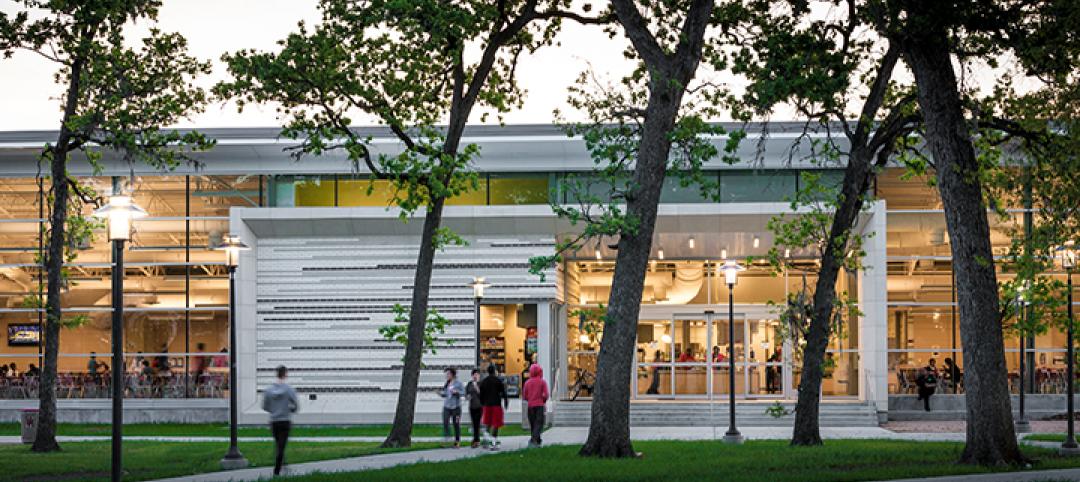Worcester, Mass., is the birthplace of vocational education, beginning with the pioneering efforts of Milton P. Higgins, who opened the Worcester Trade School in 1908. The school's original facility served this central Massachusetts community for nearly 100 years until its state-of-the-art replacement opened in 2006 as the 1,500-student Worcester Technical High School.
Getting the new 400,000-sf school opened, however, once again required pioneering efforts that earned this project and its Building Team a Special Recognition Award for overcoming significant challenges, including an environmentally sensitive site, tight funding, and labor union issues.
The school's 21-acre site in the city's Green Hill Park included wetlands with vernal pools, a 16-acre landfill, and a two-year legal dispute with neighbors over environmental and parkland issues. A formal partnering charter ultimately allayed neighborhood and environmental concerns. The school was repositioned on the site, and improvements were made to the wetlands and vernal pools, which now serve as leaning labs for the school's Environmental Technology program. The landfill was capped and converted for use as the school's athletic fields.
Funding was one of the project's biggest obstacles. To offset the school's approximately $90 million total cost (construction costs: $68 million; equipment: $22 million), the school's advisory board created “entrustment” programs, which involved partnerships with businesses, manufacturers, and major suppliers—notably Dell Computers, Cisco Systems, Toyota, and Redken 5th Avenue—to provide equipment and industry expertise in return for the school's exclusive use of their products.
Labor union issues were resolved through a deal brokered by the city's mayor and Consigli Construction (general contractor in a joint venture with O'Connor Constructors) that allowed non-union trades to bid the project. Originally, only union trades were allowed to bid, but that prevented the school's alumni who weren't union members or employees of union signatory firms from submitting bids. Trades winning their bids served as mentors to the school's current students, who gained valuable hands-on experience by helping complete their new school two months early and on budget.
|
Related Stories
| Jul 19, 2013
Reconstruction Sector Construction Firms [2013 Giants 300 Report]
Structure Tone, DPR, Gilbane top Building Design+Construction's 2013 ranking of the largest reconstruction contractor and construction management firms in the U.S.
| Jul 19, 2013
Renovation, adaptive reuse stay strong, providing fertile ground for growth [2013 Giants 300 Report]
Increasingly, owners recognize that existing buildings represent a considerable resource in embodied energy, which can often be leveraged for lower front-end costs and a faster turnaround than new construction.
| Jul 19, 2013
Best in brick: 7 stunning building façades made with brick [slideshow]
The Brick Industry Association named the winners of its 2013 Brick in Architecture Awards. Here are seven winning projects that caught our eye.
| Jul 2, 2013
LEED v4 gets green light, will launch this fall
The U.S. Green Building Council membership has voted to adopt LEED v4, the next update to the world’s premier green building rating system.
| Jul 1, 2013
Report: Global construction market to reach $15 trillion by 2025
A new report released today forecasts the volume of construction output will grow by more than 70% to $15 trillion worldwide by 2025.
| Jun 28, 2013
Building owners cite BIM/VDC as 'most exciting trend' in facilities management, says Mortenson report
A recent survey of more than 60 building owners and facility management professionals by Mortenson Construction shows that BIM/VDC is top of mind among owner professionals.
| Jun 17, 2013
DOE launches database on energy performance of 60,000 buildings
The Energy Department today launched a new Buildings Performance Database, the largest free, publicly available database of residential and commercial building energy performance information.
| Jun 5, 2013
USGBC: Free LEED certification for projects in new markets
In an effort to accelerate sustainable development around the world, the U.S. Green Building Council is offering free LEED certification to the first projects to certify in the 112 countries where LEED has yet to take root.
| Jun 3, 2013
Construction spending inches upward in April
The U.S. Census Bureau of the Department of Commerce announced today that construction spending during April 2013 was estimated at a seasonally adjusted annual rate of $860.8 billion, 0.4 percent above the revised March estimate of $857.7 billion.
| May 21, 2013
7 tile trends for 2013: Touch-sensitive glazes, metallic tones among top styles
Tile of Spain consultant and ceramic tile expert Ryan Fasan presented his "What's Trending in Tile" roundup at the Coverings 2013 show in Atlanta earlier this month. Here's an overview of Fasan's emerging tile trends for 2013.















